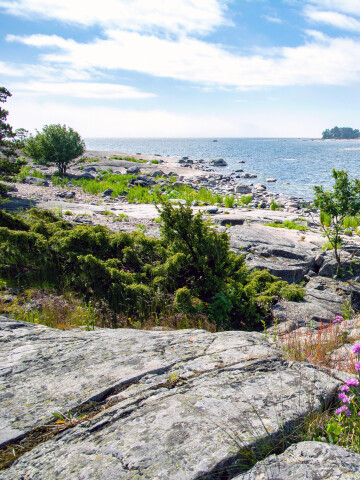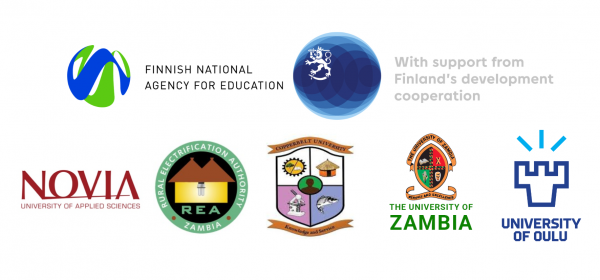
FUI-Bloggen
FUI är förkortningen för forskning, utveckling och innovation. I FUI-bloggen skriver Yrkeshögskolan Novias personal om sitt jobb, forskning, projektverksamhet och andra betraktelser.
Blogginlägg som är granskat av Novias redaktionsråd är utmärkta med nyckelordet "Granskat inlägg".
Vi följer CC-BY 4.0 om inget annat nämns.
Enhancing Circular Literacy in Zambia- experiences from the SF BioVAC project

Circular Economy (CE) has been discussed intensively in Europe over the last years. The concept is strongly related to the twin transition and the EU’s green deal (Uhrenholt et al., 2022). It has been stressed that production systems must become circular rather than linear, as we need to limit the demand for new materials and natural resources. Also, future generations should be able to enjoy their lives on our planet; thus, we can’t create waste and extract scarce resources in the same way as we have in the last decades. Hence, especially in educational institutions, circular literacy, i.e., the competency to act for circularity, should be enhanced. In the SF BioVac project coordinated by Novia University of Applied Sciences, one of the aims is to deepen the knowledge about Circular Economy in the Zambian partner universities, the University of Zambia and Copperbelt University.
The Circular Economy and circular literacy
CE has been described as an approach to overcome current challenges, like climate change and overconsumption of resources (Holmberg &Konttinen, 2023). For the world to become more circular, the need for circularity must be communicated throughout society. All people must understand why our economic system has to be transformed, production processes improved and consumer behavior changed. It is important to emphasize that it is also always a human being or a group of people making business-related decisions and political choices. Thus, to make better decisions, the knowledge about CE must be deepened and attitudes changed. Moving to a circular economy requires fundamental transformations across markets, technologies, and institutions. (Rizos et al., 2025)
As a concept, circular economy is complex (see e.g., Rizos et al., 2017). To make CE mainstream in more industries, there is still a significant amount of work to be done. Moreover, to reach an expert-level understanding of CE, you usually have to work in a certain industry for years. Even then, the know-how will be limited to implementing circularity in that industry. But not everyone needs to be an expert; a first step could be to acknowledge that a circular mindset, rather than compulsive buying, should thrive among consumers. (Circular Berlin, nd).
A circular mindset should be further developed towards circular literacy. The concept of circular literacy is still in the process of evolving. “Circular literacy” has, for instance, been described as “the need for people in a circular society to understand the current system, understand where we want to go, and then understand how to get there, as a prerequisite for making a circular economy a reality” (Sustainability Directory, 2025). Only understanding the current system, however, is not enough for an actual transformation. Worldwide, the circularity of production systems is, in fact, decreasing (Forbes, 2025). Thus, people need to act for change and not only gain more knowledge about CE.
In an article, Holmberg & Konttinen (2024) defined sustainability literacy as a term comprising knowledge, skills, and attitude. Circular literacy can be seen through the same lenses. CE-related knowledge, skills, and attitudes must be strengthened at all levels to make the circular economy mainstream. This is one of the starting points in the SF BioVac project, primarily targeting biogas and the extensive waste management problems that the target country of the project, Zambia, is currently facing.
Enhancing circular literacy through an online course
One of the key challenges for Zambian people and businesses is the limited availability of electricity. Thus, the circular economy has been identified as a solution for the energy shortage, as both food waste and animal manure can be converted into biogas. The SF BioVac project, funded by the Ministry for Foreign Affairs, Finland, aims especially at testing the use of animal manure in biogas plants, providing energy for cooking in rural Zambia. To build the capacity related to biogas, sustainability, and the circular economy, the project also comprised courses related to these topics offered to staff and students at two partner universities in Zambia. The author of this blog was responsible for the introduction to the Circular Economy course.
The “Introduction to Circular Economy” course was offered to both students and staff from the partner universities. The course consisted of five assignments, based on pre-identified material delivered on a digital platform, and three live sessions for discussions. During the course, it became evident that Zambian students already understand the basics of the concept and recognize the importance of improving waste management throughout society. Participants expressed major interest in learning about strategies to implement the Circular Economy in Europe, and reflection upon how the CE could be further enhanced in Zambia. In the live sessions, solutions for how we in Finland circulate bottles, medicines, and textiles were introduced. For Zambia, it was highlighted that a key challenge to be solved is the huge amount of municipal solid waste. As one of the participants stated during one of the live sessions in Teams: “The Municipal Solid Waste (MSW) value chain is one of the most direct and visible opportunities for Zambia’s transition to a circular economy. It offers strong medium-term potential, but unlocking its financial and societal value requires coordinated action. Public-private partnerships are essential to mobilize investment in logistics and infrastructure”.
The course also included discussions on new business models based on Circular Economy principles that could be applicable in African countries. In Zambia, there is a need to stimulate the private sector interest in circular business models (Clube & Hazema, 2024), but so far, there are few success stories. During the discussions about the challenges related to CE and waste management, in a Zambian context, it became clear that for most Zambians, daily struggles overshadow the interest in sorting waste and identifying business opportunities related to CE. The university students and staff participating in the course were convinced that the younger generations (school children and teens) could be educated in order to, as adults, be able to boost the circular economy. As the old saying states, it is difficult for an old dog to learn new tricks. A fact is that older generations in Zambia probably won’t change their habits related to sorting waste. Thus, curricula introducing circular literacy should be developed for educational institutions at different levels. For instance, in Finland CE and responsible consumer behavior are discussed from grade 1 (University of Helsinki, nd)
Conclusion
In recent years, political decision-makers in Zambia have become more aware of the importance of enhancing sustainability. The country is actively following the principles of circular economy as a key strategy for sustainable development. It is seen as crucial to find solutions for how to transform waste into new resources and thereby reduce pollution and waste at the same time as economic growth is achieved. Significant market opportunities exist in separating and trading waste, waste-to-energy projects, and recycling, in textiles and mining (Tandem, 2024). It is, however, not easy to enhance circularity in Zambia as the country faces inadequate infrastructure, a lack of regulations, and policy gaps (Haigh, 2023). On the other hand, Zambia needs to initiate efforts as the waste problem is huge, and a project like the SF BioVac project is a step in the right direction.
It was eye-opening to introduce and discuss a complex concept such as the circular economy to a country like Zambia. As a teacher, I needed to clarify that our Finnish solutions might not be transferable to Zambia. Moreover, I realized that the circular problems we are facing, for instance, with fast fashion, do not exist in a Zambian context. Many things that we in Finland see as self-evident, such as sorting household waste, are challenges to be solved in Zambia. Shortage of electricity is a daily concern as “load shedding” is common in urban areas. Moreover, large rural areas lack electricity. However, the overall standard of living has improved in Zambia, and the country is in its development stages, strongly emphasizing sustainable solutions and the need for circular production processes.
Even if Finnish solutions for sustainability might not always be optimal for Zambia, projects like the SF BioVac project can plant a seed for future actions towards circularity in different industries, as well as in society in general. The feedback received from the “Introduction to Circular Economy” course shows that circular literacy can be enhanced through projects. Hopefully, the students participating in the course will become future change-makers in their local communities and in the companies that employ them.

Resources
Circular Berlin (nd). Closing the skills gap: vocational education & training for the circular economy. https://cdn.prod.website-files.com/5d26d80e8836af2d12ed1269/608c0aa6fec4df0fa7bd78e4_20210422%20-%20CJI%20VET%20Paper%202%20-%20297x210mm.pdf
Clube R. & Hazemba, M. (2024). From Waste to Resource: Creating an Enabling Policy Environment for a Circular Economy in Zambia. https://climatecompatiblegrowth.com/wp-content/uploads/From-Waste-to-Resource-Zambia-1.pdf
Forbes (2025). Why The Circular Economy Is Failing And How It Can Actually Work. https://www.forbes.com/councils/forbesbusinesscouncil/2025/04/18/why-the-circular-economy-is-failing-and-how-it-can-actually-work/
Haigh, A. (2023). Turning Trash into Treasure: The Potential of Waste-to-Energy in Zambia. https://www.linkedin.com/pulse/turning-trash-treasure-potential-waste-to-energy-zambia-haigh/
Holmberg, E., Konttinen, A. (2023). Circular Economy in Tourism and Hospitality – a Nordic Perspective. In: Köchling, A., Seeler, S., van der Merwe, P., Postma, A. (eds) Towards Sustainable and Resilient Tourism Futures. Schriftenreihe des Deutschen Instituts für Tourismusforschung, vol 1. Erich Schmidt Verlag GmbH & Co. KG, Berlin. https://doi.org/10.37307/b.978-3-503-21195-1.08
Holmberg, E & Konttinen, A. (2024). Striving for Sustainability Literacy in Tourism Students: Insights from Finland and South Africa. UAS Journal. https://uasjournal.fi/4-2024/striving-for-sustainability-literacy-in-tourism-students-insights-from-finland-and-south-africa/
Rizos, V., Tuokko, K., & Behrens, A. (2017). The Circular Economy: A review of definitions, processes and impacts. CEPS papers, (12440).
Rizos, V. & Zambianchi, R. (2025). Unpacking policy coherence: A network analysis of the EU policy mix for the circular economy, Sustainable Production and Consumption, Volume 60, 52-63.
Sustainability Directory (2025). Circular Literacy. https://lifestyle.sustainability-directory.com/term/circular-literacy/
Tandem (2024). Zambia Cirular Economy Study 2024. https://finlandabroad.fi/documents/6314947/0/Zambia+Circular+Economy+Study+2024.pdf/85afc68a-0be2-2aa8-39f0-ed8298576172?t=1738656845440
Uhrenholt, J.N., Kristenses, J.H., Adamsen, S., Jensen, S.F., Colli, M., Waehrens, B.V., 2022. Twin transition: synergies between circular economy and internet of things – a study of Danish manufacturers. J. Circ. Econ. 1, 1–19. https://doi.org/10.55845/ hrgw4040
University of Helsinki (nd). Kiertotalous perusopetuksen opetussuunnitelman perusteissa. https://blogs.helsinki.fi/kiertotaloudenkeksinnot/kiertotalous/kiertotalous-opsssa/
Texten har granskats och godkänts av Novias redaktionsråd 17.11.2025.
![]()
FUI-Bloggen
Blogginlägg som är granskat av Novias redaktionsråd är utmärkta med nyckelordet "Granskat inlägg".
Vi följer CC-BY 4.0 om inget annat nämns.
Ansvarsfriskrivning: Författaren/författarna ansvarar för för fakta, möjlig utebliven information och innehållets korrekthet i bloggen. Texterna har genomgått en granskning, men de åsikter som uttrycks är författarens egna och återspeglar inte nödvändigtvis Yrkeshögskolan Novias ståndpunkter.
Disclaimer: The author(s) are responsible for the facts, any possible omissions, and the accuracy of the content in the blog.The texts have undergone a review, however, the opinions expressed are those of the author and do not necessarily reflect the views of Novia University of Applied Sciences.
Posta din kommentar
Kommentarer
Inga har kommenterat på denna sida ännu